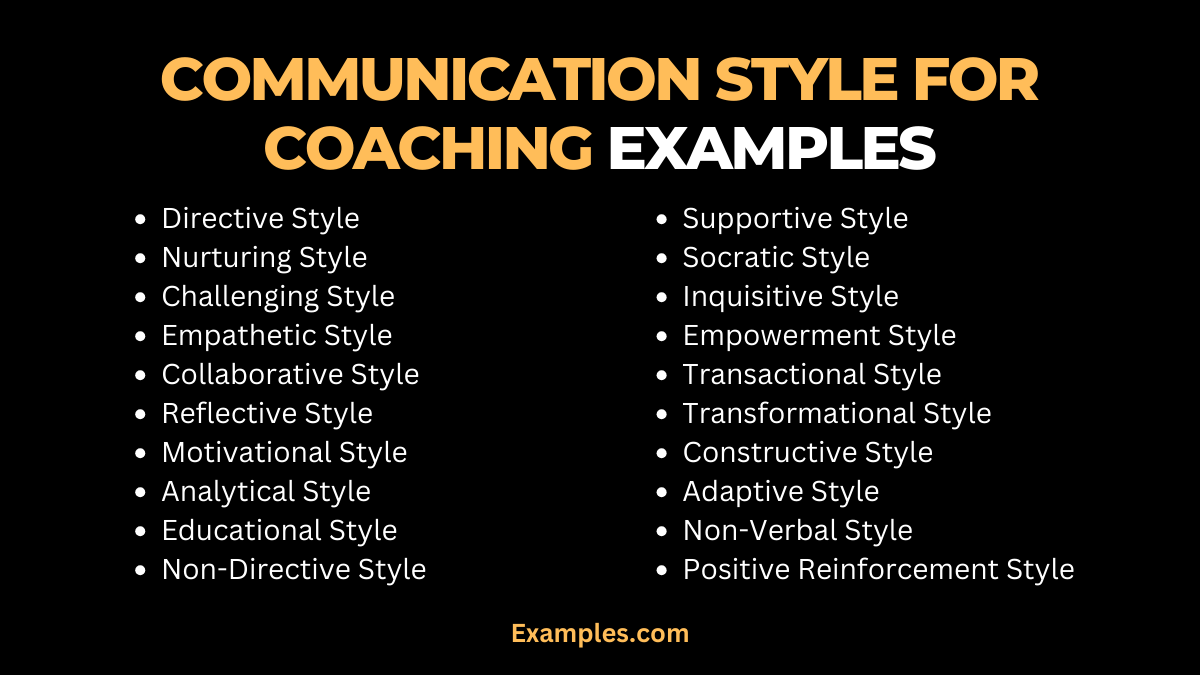19+ Communication Style for Coaching Examples
Understanding the intricacies of communication in coaching is crucial for fostering growth and development. This comprehensive guide delves into the world of coaching communication styles, providing clear meanings, real-life examples, and actionable insights. Discover how effective Communication Examples can enhance your coaching journey.
What is Communication Style for Coaching? – Meaning

In simple terms, coaching communication style refers to the way coaches interact with their clients. It encompasses the methods, techniques, and approaches employed to convey information, motivate, and facilitate personal and professional growth through coaching.
What is the Best Example of Communication Style for Coaching?

Delve into a detailed exploration of a prime example of effective coaching communication. Learn how exemplary coaches utilize their communication skills to inspire, guide, and empower their clients to achieve remarkable results.
20 Communication Style for Coaching Examples

Explore 20 coaching communication styles with brief descriptions, causes, and solutions:
- Directive Style: Clear instructions, balance with client input.
- Nurturing Style: Over-support, encourage self-reliance.
- Challenging Style: Push clients, ensure constructive challenges.
- Empathetic Style: Emotional involvement, maintain boundaries.
- Collaborative Style: Involve clients, avoid over-collaboration.
- Reflective Style: Reflecting thoughts, mix with action strategies.
- Motivational Style: Inspire, set achievable goals.
- Analytical Style: Data-driven, include emotions.
- Educational Style: Teach, encourage self-discovery.
- Non-Directive Style: Minimal guidance, offer structure.
- Supportive Style: Provide a safety net, foster risk-taking.
- Socratic Style: Excessive questioning, balance with listening.
- Inquisitive Style: Curious, respect client boundaries.
- Empowerment Style: Promote self-efficacy, increase responsibilities.
- Transactional Style: Outcome-focused, combine with personal growth.
- Transformational Style: Inspirational, balance with practicality.
- Constructive Style: Critical feedback, offer solutions.
- Adaptive Style: Flexible, maintain consistency.
- Non-Verbal Style: Limited verbal, enhance communication.
- Positive Reinforcement Style: Constant praise, recognize and challenge.
Communication Style for Coaching in the Workplace
Effective coaching in the workplace leverages diverse Communication Styles Examples, from assertive to reflective, to enhance interpersonal relationships and leadership dynamics. Key to successful coaching is adapting to various Types of Communication Styles to fit the context and individual needs.
- Assertive Coaching: “When giving feedback, clearly state the observed behavior and its impact without blame.” This style involves direct and honest communication, focusing on problem-solving and respect.
- Passive Coaching: “I understand your perspective, let’s consider all options together.” Here, the coach avoids confrontation, emphasizing listening and understanding.
- Aggressive Coaching: “This needs to change now; let’s focus on immediate action.” This approach is forceful and direct, often focusing on quick results.
- Passive-Aggressive Coaching: “Fine, we’ll do it your way, but remember my previous advice.” This style combines indirect communication with a subtle assertion of one’s own views.
- Reflective Coaching: “What I’m hearing is your concern about deadlines. How do you propose we address this?” This style focuses on active listening and reflecting back the speaker’s thoughts and feelings.
Verbal Communication Style for Coaching
Verbal communication in coaching is essential for conveying clear messages and fostering Open Communication Styles. It’s about selecting the right words and tone to match the coaching context and relationship.
- Directive Style: “Let’s set specific goals for your project.” Here, the coach provides clear, specific instructions or information.
- Exploratory Style: “Can you tell me more about your challenges with this task?” This style involves asking open-ended questions to encourage deeper understanding.
- Informative Style: “Based on my experience, this strategy might work well in your situation.” This approach involves sharing knowledge or information to guide.
- Casual Style: “How was your weekend? Let’s catch up before we start.” This approach is informal, fostering a relaxed environment.
- Motivational Style: “You have the skills to succeed in this project; let’s break down the steps.” This style is uplifting and encouraging, focusing on boosting confidence.
Download Communication Styles Training Course in PDF
Assertive Communication Style for Coaching
An assertive communication style in coaching is about expressing oneself confidently and respectfully, encouraging a balance between open and Reflective Communication Styles. It’s highly effective in leadership and in establishing healthy workplace relationships.
- Direct Feedback: “Your report was well-organized, but let’s work on making the conclusions stronger.” This approach involves clear, specific, and constructive feedback.
- Boundary Setting: “I can discuss this with you after our scheduled meeting.” Here, the coach sets clear personal or professional boundaries.
- Open Dialogue: “Let’s openly discuss the pros and cons of this strategy.” This style encourages frank and two-way communication.
- Positive Reinforcement: “You’ve made great progress; let’s build on these strengths.” It involves acknowledging achievements and encouraging further development.
- Solution-Focused: “I see the issue. Let’s brainstorm potential solutions together.” This style is centered on problem-solving and collaboration.
How do you use a Coaching Communication Style to Develop Team Members?
Using a coaching communication style to develop team members is a dynamic process, integral to creating a productive and harmonious work environment. This style is especially critical for managers and project managers who need to navigate complex team dynamics and project requirements effectively.
- Active Listening and Empathy: Focus on truly understanding each team member’s perspective, encouraging open dialogue and trust.
- Goal-Oriented Feedback: Provide clear, constructive feedback aimed at helping team members reach their professional goals. This is particularly essential in a Communication Style for Managers.
- Facilitate Problem-Solving: Empower team members to identify and solve problems independently, a crucial aspect of a Communication Style for Project Managers.
- Encourage Personal Development: Help team members identify their strengths and areas for growth, fostering a culture of continuous learning.
- Promote Team Collaboration: Use inclusive communication techniques to build a strong, unified team, enhancing overall Communication Style for Work.
Communication Style for Coaching Learning Style
The communication style for coaching learning is a dynamic approach that adapts to individuals’ unique learning styles and preferences. It emphasizes open dialogue, active listening, and personalized guidance to create an optimal learning environment. Coaches Employing Style aim to understand and cater to learners’ specific needs, promoting better comprehension and retention of knowledge. By aligning Coaching Learning Skills, coaches can enhance the learning experience, foster engagement, and facilitate more effective skill development.
What is the Important Communication Style for Coaching?
The most effective communication style for coaching is adaptive, empathetic, and clear. It’s about understanding and addressing the unique needs of individuals, whether they are students, professionals preparing for an interview, or team members in a coaching scenario.
- Empathetic and Supportive: This style is vital for creating a trusting and open environment, especially when coaching students who might need extra encouragement.
- Clear and Concise: Essential during interview coaching, where clear communication can make a significant difference.
- Feedback-Oriented: Involves providing constructive feedback, a cornerstone in effective coaching.
- Active Listening: Ensures that the coach understands the concerns and aspirations of the individual, tailoring the coaching accordingly.
- Goal-Oriented Dialogue: Focuses on setting and achieving specific objectives, crucial for successful coaching outcomes.
What are the Benefits of using a Coaching Communication Style?
Adopting a coaching communication style enhances interactions, whether in interviews or in educational settings. It fosters a supportive environment that promotes growth and understanding. This approach is particularly effective in tailoring communication style for interviews and addressing the unique needs of students.
- Enhanced Clarity and Understanding: This style focuses on clear, concise communication. It aids interviewers in conveying their expectations effectively and helps students grasp complex concepts with ease.
- Increased Engagement and Participation: By encouraging open dialogue, this approach makes interviews more interactive and classroom sessions more engaging. It motivates students to participate actively and interviewees to engage more deeply with the process.
- Personalized Feedback and Guidance: Tailoring the communication to individual needs ensures that feedback is constructive and personalized, whether it’s for a student’s academic progress or an interviewee’s performance.
- Building Trust and Rapport: A coaching style of communication establishes a foundation of trust, essential for a productive learning environment for students and a comfortable atmosphere during interviews.
- Empowering and Motivating: This style empowers individuals, whether they are students or interview candidates, by encouraging self-reflection and self-improvement, leading to increased motivation and self-confidence.
What are the types of Communication Styles?
The four types of communication styles are Assertive Communication Styles, Passive Communication Styles, Aggressive Communication Styles, and Passive-Aggressive Communication Styles. Each style impacts interactions differently and can be refined using communication style worksheets and assessments.
What is Good Communication in Coaching?
Good communication in coaching involves clarity, empathy, active listening, and adaptability. Effective coaches tailor their approach based on communication style with management and individual needs.
What are the main Communication Styles?
The five Communication Styles are Assertive, Aggressive, Passive-Aggressive, Passive, and Manipulative. Understanding these styles is key in how to improve communication style for effective interactions.
In conclusion, effective coaching communication styles exemplify the power of inspiration, guidance, and skillful interaction. Through these examples, we witness the transformative impact coaches can have on their clients, leading to remarkable personal and professional growth. These coaching methods serve as a testament to the potential for positive change when communication is harnessed as a tool for empowerment and achievement.
19+ Communication Style for Coaching Examples

Understanding the intricacies of communication in coaching is crucial for fostering growth and development. This comprehensive guide delves into the world of coaching communication styles, providing clear meanings, real-life examples, and actionable insights. Discover how effective Communication Examples can enhance your coaching journey.
What is Communication Style for Coaching? – Meaning

In simple terms, coaching communication style refers to the way coaches interact with their clients. It encompasses the methods, techniques, and approaches employed to convey information, motivate, and facilitate personal and professional growth through coaching.
What is the Best Example of Communication Style for Coaching?

Delve into a detailed exploration of a prime example of effective coaching communication. Learn how exemplary coaches utilize their communication skills to inspire, guide, and empower their clients to achieve remarkable results.
20 Communication Style for Coaching Examples

Explore 20 coaching communication styles with brief descriptions, causes, and solutions:
Directive Style: Clear instructions, balance with client input.
Nurturing Style: Over-support, encourage self-reliance.
Challenging Style: Push clients, ensure constructive challenges.
Empathetic Style: Emotional involvement, maintain boundaries.
Collaborative Style: Involve clients, avoid over-collaboration.
Reflective Style: Reflecting thoughts, mix with action strategies.
Motivational Style: Inspire, set achievable goals.
Analytical Style: Data-driven, include emotions.
Educational Style: Teach, encourage self-discovery.
Non-Directive Style: Minimal guidance, offer structure.
Supportive Style: Provide a safety net, foster risk-taking.
Socratic Style: Excessive questioning, balance with listening.
Inquisitive Style: Curious, respect client boundaries.
Empowerment Style: Promote self-efficacy, increase responsibilities.
Transactional Style: Outcome-focused, combine with personal growth.
Transformational Style: Inspirational, balance with practicality.
Constructive Style: Critical feedback, offer solutions.
Adaptive Style: Flexible, maintain consistency.
Non-Verbal Style: Limited verbal, enhance communication.
Positive Reinforcement Style: Constant praise, recognize and challenge.
Communication Style for Coaching in the Workplace
Effective coaching in the workplace leverages diverse Communication Styles Examples, from assertive to reflective, to enhance interpersonal relationships and leadership dynamics. Key to successful coaching is adapting to various Types of Communication Styles to fit the context and individual needs.
Assertive Coaching: “When giving feedback, clearly state the observed behavior and its impact without blame.” This style involves direct and honest communication, focusing on problem-solving and respect.
Passive Coaching: “I understand your perspective, let’s consider all options together.” Here, the coach avoids confrontation, emphasizing listening and understanding.
Aggressive Coaching: “This needs to change now; let’s focus on immediate action.” This approach is forceful and direct, often focusing on quick results.
Passive-Aggressive Coaching: “Fine, we’ll do it your way, but remember my previous advice.” This style combines indirect communication with a subtle assertion of one’s own views.
Reflective Coaching: “What I’m hearing is your concern about deadlines. How do you propose we address this?” This style focuses on active listening and reflecting back the speaker’s thoughts and feelings.
Verbal Communication Style for Coaching
Verbal communication in coaching is essential for conveying clear messages and fostering Open Communication Styles. It’s about selecting the right words and tone to match the coaching context and relationship.
Directive Style: “Let’s set specific goals for your project.” Here, the coach provides clear, specific instructions or information.
Exploratory Style: “Can you tell me more about your challenges with this task?” This style involves asking open-ended questions to encourage deeper understanding.
Informative Style: “Based on my experience, this strategy might work well in your situation.” This approach involves sharing knowledge or information to guide.
Casual Style: “How was your weekend? Let’s catch up before we start.” This approach is informal, fostering a relaxed environment.
Motivational Style: “You have the skills to succeed in this project; let’s break down the steps.” This style is uplifting and encouraging, focusing on boosting confidence.
Download Communication Styles Training Course in PDF
Assertive Communication Style for Coaching
An assertive communication style in coaching is about expressing oneself confidently and respectfully, encouraging a balance between open and Reflective Communication Styles. It’s highly effective in leadership and in establishing healthy workplace relationships.
Direct Feedback: “Your report was well-organized, but let’s work on making the conclusions stronger.” This approach involves clear, specific, and constructive feedback.
Boundary Setting: “I can discuss this with you after our scheduled meeting.” Here, the coach sets clear personal or professional boundaries.
Open Dialogue: “Let’s openly discuss the pros and cons of this strategy.” This style encourages frank and two-way communication.
Positive Reinforcement: “You’ve made great progress; let’s build on these strengths.” It involves acknowledging achievements and encouraging further development.
Solution-Focused: “I see the issue. Let’s brainstorm potential solutions together.” This style is centered on problem-solving and collaboration.
How do you use a Coaching Communication Style to Develop Team Members?
Using a coaching communication style to develop team members is a dynamic process, integral to creating a productive and harmonious work environment. This style is especially critical for managers and project managers who need to navigate complex team dynamics and project requirements effectively.
Active Listening and Empathy: Focus on truly understanding each team member’s perspective, encouraging open dialogue and trust.
Goal-Oriented Feedback: Provide clear, constructive feedback aimed at helping team members reach their professional goals. This is particularly essential in a Communication Style for Managers.
Facilitate Problem-Solving: Empower team members to identify and solve problems independently, a crucial aspect of a Communication Style for Project Managers.
Encourage Personal Development: Help team members identify their strengths and areas for growth, fostering a culture of continuous learning.
Promote Team Collaboration: Use inclusive communication techniques to build a strong, unified team, enhancing overall Communication Style for Work.
Communication Style for Coaching Learning Style
The communication style for coaching learning is a dynamic approach that adapts to individuals’ unique learning styles and preferences. It emphasizes open dialogue, active listening, and personalized guidance to create an optimal learning environment. Coaches Employing Style aim to understand and cater to learners’ specific needs, promoting better comprehension and retention of knowledge. By aligning Coaching Learning Skills, coaches can enhance the learning experience, foster engagement, and facilitate more effective skill development.
What is the Important Communication Style for Coaching?
The most effective communication style for coaching is adaptive, empathetic, and clear. It’s about understanding and addressing the unique needs of individuals, whether they are students, professionals preparing for an interview, or team members in a coaching scenario.
Empathetic and Supportive: This style is vital for creating a trusting and open environment, especially when coaching students who might need extra encouragement.
Clear and Concise: Essential during interview coaching, where clear communication can make a significant difference.
Feedback-Oriented: Involves providing constructive feedback, a cornerstone in effective coaching.
Active Listening: Ensures that the coach understands the concerns and aspirations of the individual, tailoring the coaching accordingly.
Goal-Oriented Dialogue: Focuses on setting and achieving specific objectives, crucial for successful coaching outcomes.
What are the Benefits of using a Coaching Communication Style?
Adopting a coaching communication style enhances interactions, whether in interviews or in educational settings. It fosters a supportive environment that promotes growth and understanding. This approach is particularly effective in tailoring communication style for interviews and addressing the unique needs of students.
Enhanced Clarity and Understanding: This style focuses on clear, concise communication. It aids interviewers in conveying their expectations effectively and helps students grasp complex concepts with ease.
Increased Engagement and Participation: By encouraging open dialogue, this approach makes interviews more interactive and classroom sessions more engaging. It motivates students to participate actively and interviewees to engage more deeply with the process.
Personalized Feedback and Guidance: Tailoring the communication to individual needs ensures that feedback is constructive and personalized, whether it’s for a student’s academic progress or an interviewee’s performance.
Building Trust and Rapport: A coaching style of communication establishes a foundation of trust, essential for a productive learning environment for students and a comfortable atmosphere during interviews.
Empowering and Motivating: This style empowers individuals, whether they are students or interview candidates, by encouraging self-reflection and self-improvement, leading to increased motivation and self-confidence.
What are the types of Communication Styles?
The four types of communication styles are Assertive Communication Styles, Passive Communication Styles, Aggressive Communication Styles, and Passive-Aggressive Communication Styles. Each style impacts interactions differently and can be refined using communication style worksheets and assessments.
What is Good Communication in Coaching?
Good communication in coaching involves clarity, empathy, active listening, and adaptability. Effective coaches tailor their approach based on communication style with management and individual needs.
What are the main Communication Styles?
The five Communication Styles are Assertive, Aggressive, Passive-Aggressive, Passive, and Manipulative. Understanding these styles is key in how to improve communication style for effective interactions.
In conclusion, effective coaching communication styles exemplify the power of inspiration, guidance, and skillful interaction. Through these examples, we witness the transformative impact coaches can have on their clients, leading to remarkable personal and professional growth. These coaching methods serve as a testament to the potential for positive change when communication is harnessed as a tool for empowerment and achievement.


